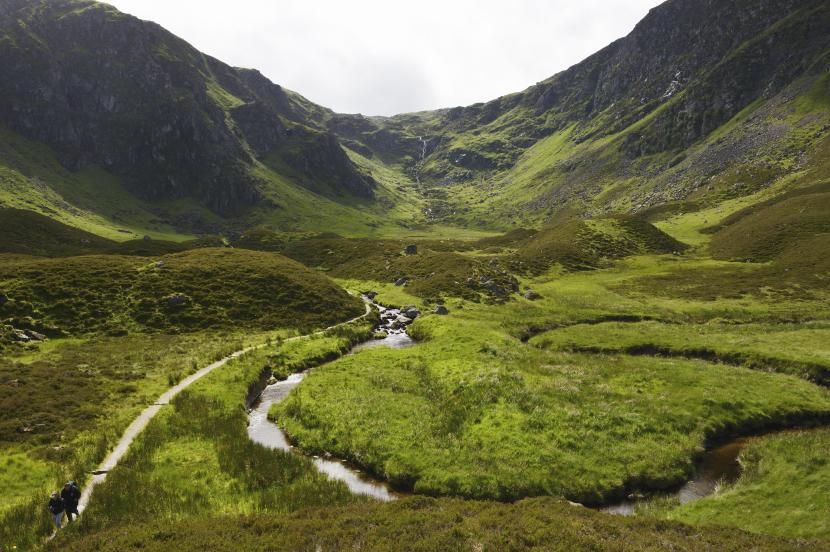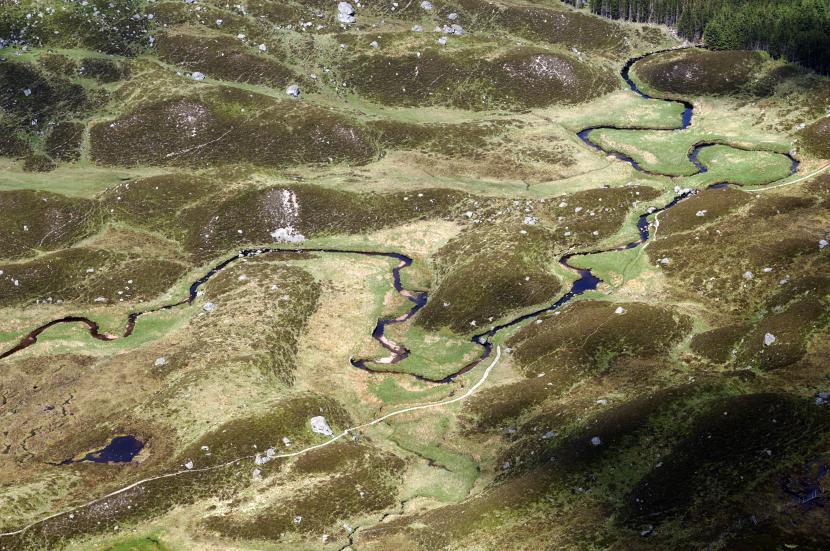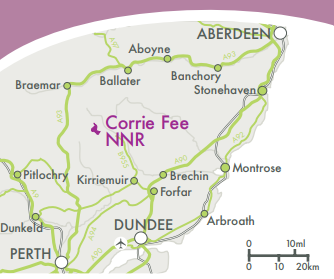Corrie Fee NNR - visiting the reserve leaflet
Read in Gaelic / Leugh ann an Gàidhlig
Welcome to Corrie Fee National Nature Reserve
Walk up the Corrie Fee Trail to the edge of Glen Doll forest and enjoy the views of the natural amphitheatre of Corrie Sharroch and the slopes of Craig Rennet, formed by glaciers and ice.
Welcome to the botanical paradise of Corrie Fee National Nature Reserve, managed by Scottish Natural Heritage. There are nine National Nature Reserves in and around the Cairngorms National Park.
Follow the burn as it flows down the corrie and discover the plants, birds and mammals that make this quiet mountain landscape special.
With the correct equipment, you can walk up through the corrie to the Cairngorm plateau and onward to the nearby Munros of Mayar and Dreish to experience the whole upland atmosphere.

Getting there
What to see in Corrie Fee
Follow a glacier’s journey. Imagine its strength when it carved out the cliffs and corrie. Walk between the hummocks and erratics that show where its power literally melted away.
Look out for white bog cotton, yellow bog asphodel and purple cross- leaved heath flowers brightening the wet flushes between May and August.
Discover the deep blue delicate milkwort and sunshine yellow tormentil between June and August when their flowers nestle amongst the drier heath.
Watch the Fee, white with bubbles or winter ice, where it tumbles down the steep back wall, turning peat-stained brown as it sedately meanders across the valley floor, turning here and there around the hummocks.
Find alpine lady’s mantle, one of the more widespread arctic alpine plants with frothy yellow flowers above silver backed leaves.

Trail tips
- The Corrie Fee Trail runs for about 5km, beginning in the Glen Doll car park and finishing at the top of the corrie.
- Corrie Fee NNR is reached after walking about 3.5km (roughly 45 minutes) along the waymarked forest trail to the edge of the wood, where you can see into the corrie.
- You can continue your walk following the unmarked trail about 1.5 km through the Reserve. This climbs 670m up to the top of the corrie and onto the Cairngorm plateau. Allow about 2 hours there and back to the edge of the forest. The track becomes a steep mountain trail, so you need to be prepared for rough ground that can sometimes be slippery or icy. Some sections of the path are steep with cross drains and short areas of unguarded boardwalk.
- You will need walking boots with a good tread, warm and waterproof clothing, and food and drink for a whole day’s excursion.
- Be prepared for sudden changes in mountain weather, including sleet or snow between autumn and late spring. Leaving the car park in sunshine does not mean that it will be warm and dry higher up as mountain conditions change very rapidly.
- Remember the Scottish Outdoor Access Code. Help protect Corrie Fee NNR’s fragile environment by keeping to the path to prevent erosion, leaving it undisturbed and free of litter. Respect other people’s privacy, their need for quiet enjoyment, and please keep dogs under control.

The Angus Glens Ranger Service lead guided walks throughout the year. Tel: 01575 550233 Email: [email protected]

Woodland wonders
The trail to Corrie Fee first takes you through a working forest, originally planted in the 1950s and 1960s for timber, and today managed by the Forestry Commission Scotland to also encourage a wider variety of tree species and create sustainable habitats for wildlife. You can see Sitka spruce, Scots pine, larch and broadleaved trees like birch along the sides of the forest streams and rivers.
As you walk up through the forest look out for woodland plants and colourful fungi in the autumn. Tread quietly and you may see some of the wildlife here, such as red squirrel, roe deer, dipper and crossbill. Signal posts along the trail will reveal some of the things you will see on route to Corrie Fee NNR.
The corries
Giant’s armchairs carved by ice
At the tail end of the ice age 12,000 years ago there was a small glacier here in Corrie Fee. Back then, a walk through Corrie Fee would have required rope, ice axe and crampons, even in the middle of July.
As it flowed downhill, the glacier ice excavated the deep corries of Corrie Fee and Corrie Sharroch.
Similar processes happened all across the Cairngorms and other glacially carved features can be seen on the Creag Meagaidh, Muir of Dinnet and Invereshie and Inshriach NNRs.
Moraine
Earthmoving glaciers
The Cairngorm mountains northwest of Glen Doll were formed when several gigantic masses of molten rock (magma) from deep inside the earth rose up to about 6km below the surface. The magma cooled and hardened, becoming granite which was exposed millions of years later after weathering by water, frost and ice wore away the softer rock above. Today this hard granite can be seen on the summits.
Then during the Ice Age, glaciers flowed down the glen, plucking up rocks and excavating the ground underneath, carving out the rough shape of the glen over thousands of years. As the ice melted, the glaciers retreated back into the corries, leaving gravelly debris behind filling the floor of the glen.
As the Scottish climate grew warmer the Corrie Fee glacier melted, leaving behind distinctive mounds that are now covered in heather. Look out for them as you walk up through the corrie.
From the top of the corrie looking down you can see these mounds form a pattern of ridges showing how the Corrie Fee glacier melted in stages, each time leaving behind a ridge. This is known as recessional moraine.
Cliffs and crags
Arctic survivors
The harsh mountain environment of Corrie Fee NNR is a challenging place to live. The plants and animals found here have developed special ways to survive in the alpine conditions. This is one of the few places in the Cairngorms where a band of nutrient-rich rock, like hornblende schist, creates soils with plant boosters that rare arctic-alpine plants thrive on.
A thick skin and hairy legs could save your life
The fierce winds and strong sunlight would dry out the leaves of ordinary plants. Alpine saxifrage and roseroot have thick, leathery leaves to keep the moisture in. Yellow milk-vetch has stems and leaves covered with tiny white hairs that both reflect the harsh sunlight and trap a layer of moist air next to the plant.
Stay low and keep your head down
High up on the mountainside, where the icy gales blow, is the natural habitat of the gnarled, twisted, and stunted ‘wee’ trees. This natural forest fringe has been lost on most Scottish mountains but here, in Corrie Fee and Corrie Sharroch, is the most extensive remnant of this montane scrub of rare woolly and downy willow. These precious willows keep their heads down, growing low to the ground to escape the worst of the violent wind.
Early start
On these high mountains the growing season is very short. Purple saxifrage bursts into flower before the late snows have disappeared, making sure that its seeds are produced and sown before summer ends.
Pollen story
Preserved in peat
After the glacier retreated it left lochans which filled with fine peat over the last 11,000 years. Pollen from trees, shrubs and plants collected in the growing layers of peat over many summers.
Scientists have studied the peat and, from identifying the pollen trapped within it, have identified the different types of plants that used to grow here.
From this research we know that there were once areas of willow and juniper scrub, and patches of birch and hazel woodland with a few pine, oak, elm and alder.
Alpine plants, for which the corrie is protected today, have been living here continuously since the last ice age. Many of these are now found only on ledges and gullies that grazing deer cannot reach.
Balancing act
One of Britain’s last wildernesses
The pollen story tells us that Corrie Fee was one of the last areas in Britain to be changed by humans. There was little change in the natural plant cover in this remote corrie for 11,000 years.
Then about 200 years ago there was a dramatic change. The woodland virtually disappeared and grassland expanded. Plants which were one widespread across the corrie became restricted to narrow gullies.
This was a time when sheep farming was introduced and the grassland attracted more deer. Young trees and sensitive plants could not survive the grazing. The woodlands died out, but the woolly willow and a variety of now rare plants hung on in the gullies and inaccessible ledges.
This is why today we control deer numbers to protect Corrie Fee’s special plants and habitats and a fence has been used to protect the most important areas for dwarf willows.
Natural clues
The corrie floor is dotted with large boulders, called erratics, with some as big as Land Rovers. These boulders fell from the corrie walls onto the glacier and were carried along until the ice melted and they came to their final resting place where you see them today.

The Fee Burn
There are few places where you can clearly see the changes in the character of a mountain burn from a raging torrent to a more sedate meandering channel.
The Fee Burn drops over the edge of the Cairngorm plateau, freefalling down the waterfall, losing its energy and slowing as the corrie flattens. The burn dumps its sandy load to form small short-lived beaches on the inside bends. Over time the meanders of the burn shift, reworking the sediments left by the glacier on the corrie floor.
Rushes, sedges, and bog cotton that grow by the meanders are the preferred food of the water vole. We are hoping they will make a comeback having been previously all but lost to invading mink.

Put on your winter coat and hide
The mountain hare is Scotland’s only mammal which is restricted to living in higher ground. Its blue-grey coat becomes a thick white winter coat by December, with fur growing on the underside of its toes giving it ‘snow shoes’. Winter camouflage helps to protect the mountain hare in Corrie Fee from falling prey to the golden eagles hunting over the corries.
Corrie Fee NNR is part of two larger Special Protection Areas, and is of European importance for birds such as golden eagles. The crags and woodlands of the NNR are also home to other mountain birds, such as ring ouzel, peregrine falcon, twite and raven.

The top of the world
Climb to the top of the corrie and you will have reached the Cairngorm plateau, the UK’s largest area of high mountain terrain. If you continue, look out for dotterel, ptarmigan and snow bunting in this vast arctic wilderness.
Find out more on
- Visiting the reserve
- About the reserve
- Visit more of our nature reserves







